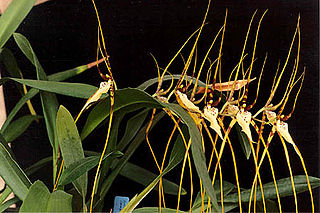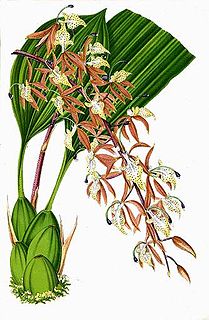
Phragmipedium is a genus of the Orchid family (Orchidaceae) and the only genus comprised in the tribe Phragmipedieae and subtribe Phragmipediinae. The name of the genus is derived from the Greek phragma, which means "division", and pedium, which means "slipper". It is abbreviated 'Phrag' in trade journals.

Stanhopea is a genus of the orchid family (Orchidaceae) from Central and South America. The abbreviation used in horticultural trade is Stan. The genus is named for the 4th Earl of Stanhope (1781-1855), president of the Medico-Botanical Society of London (1829-1837). It comprises 55 species and 5 natural hybrids. These epiphytic, but occasionally terrestrial orchids can be found in damp forests from Mexico to Trinidad to NW Argentina. Their ovate pseudobulbs carry from the top one long, plicate, elliptic leaf.

Brassia is a genus of orchids classified in the subtribe Oncidiinae. It is native to Mexico, Central America, the West Indies, and northern South America, with one species extending into Florida.

Odontoglossum, first named in 1816 by Karl Sigismund Kunth, is a genus of about 100 orchids. The scientific name is derived from the Greek words odon (tooth) and glossa (tongue), referring to the two tooth-like calluses on the base of the lip. This genus of cool to cold growing orchids is to be found on open spots in the humid cloud forest at higher elevations from Central- and West South America to Guyana, with most species around the northern Andes. The abbreviation for this genus is Odm. in the horticultural trade.

Schomburgkia is a genus of plants belonging to the family Orchidaceae. This genus is named for Richard Schomburgk, a German botanist who explored British Guiana during the 19th century. Species in this genus are either epiphytic or lithophytic in their growth habit. According to the Royal Horticultural Society Schom. is the official abbreviation for this genus.

Kraenzlinella is a genus of flowering plants from the orchid family, Orchidaceae, first described as a genus in 1903. It is native to S Mexico, Central America, and South America.
- Kraenzlinella anfracta(Luer) Luer - Tolima region in Colombia
- Kraenzlinella echinocarpa(C.Schweinf.) Luer - Peru, Ecuador
- Kraenzlinella erinacea(Rchb.f.) Solano - Oaxaca, Chiapas, Central America, Colombia, Venezuela, Guyana, Ecuador, Peru, Bolivia
- Kraenzlinella gigantea(Lindl.) Luer - Peru
- Kraenzlinella hintonii(L.O.Williams) Solano - Guerrero
- Kraenzlinella lappago(Luer) Luer - El Oro + Napo Provinces in Ecuador
- Kraenzlinella phrynoglossa(Luer & Hirtz) Luer - Azuay Province in Ecuador
- Kraenzlinella rinkeiLuer - Costa Rica
- Kraenzlinella sigmoidea(Ames & C.Schweinf.) Luer - Costa Rica
- Kraenzlinella tunguraguae(F.Lehm. & Kraenzl.) Kuntze ex Engl. & Prantl - Colombia, Ecuador, Peru
- Kraenzlinella platyrachis(Rolfe) Rolfe = Specklinia pfavii(Rchb.f.) Pupulin & Karremans
- Kraenzlinella shuarii(Luer) Luer = Echinosepala shuarii(Luer) Luer
- Kraenzlinella smaragdina(Luer) Luer = Anathallis smaragdina(Luer) Pridgeon & M.W.Chase

Ponthieva is a genus from the orchid family (Orchidaceae). They are named after Henry de Ponthieu, an English merchant of Huguenot ancestry who sent West Indian plant collections to Sir Joseph Banks in 1778.

Paphinia, abbreviated in horticultural trade Pna, is a genus of orchids, composed of an estimated 16 species from Central America, northern South America and Trinidad. These species are medium-sized epiphytes with small ovoid pseudobulbs and 2 or more leaves. The generic name comes from the Greek Paphia, the name of Aphrodite of Cyprus. Most authorities consider the genus rare.

Cycnoches, abbreviated as Cyc. in the horticultural trade, is a genus of 34 currently accepted species of orchids native to South America, Central America and southern Mexico. Also called "swan orchids", they are epiphytes found in lowland and pre-montane forests.

Rodriguezia, abbreviated Rdza. in the horticultural trade, is a genus of orchids. It consists of 49 known species, native to tropical America from southern Mexico and the Windward Islands south to Argentina, with many of the species endemic to Brazil.

Polycycnis, abbreviated in horticultural trade as Pcn, is a genus of orchid, comprising 17 species found in Central America, and northern South America.
Batemannia is a genus of flowering plants from the orchid family, Orchidaceae. It contains 5 species, native to Trinidad and South America:

Koellensteinia is a genus of flowering plants from the orchid family, Orchidaceae. It is named by Heinrich Gustav Reichenbach for the Captain Carl Kellner von Koellenstein, an Austrian military officer and a botanical correspondent of Reichenbach.

Pescatoria is a genus of flowering plants from the orchid family, Orchidaceae. It is native to Costa Rica, Panama, and northern South America.

Prescottia is a genus of flowering plants from the orchid family, Orchidaceae. It is widespread across much of Latin America and the West Indies, with one species (P. oligantha) extending into Florida.

Psilochilus is a genus of flowering plants from the orchid family, Orchidaceae. It is native to South America, Central America, Mexico and the West Indies.
- Psilochilus carinatusGaray - Colombia
- Psilochilus dusenianusKraenzl. ex Garay & Dunst. - Venezuela, Brazil
- Psilochilus macrophyllus(Lindl.) Ames - widespread from central Mexico and the West indies south to Peru
- Psilochilus maderoi(Schltr.) Schltr. - Colombia
- Psilochilus modestusBarb.Rodr. - Venezuela, Brazil
- Psilochilus mollisGaray - Ecuador
- Psilochilus physurifolius(Rchb.f.) Løjtnant - Venezuela, Guyana
- Psilochilus vallecaucanusKolan. & Szlach. - Colombia

Pterichis is a genus of flowering plants from the orchid family, Orchidaceae. It is native to South America, Central America and Jamaica.

Sarcoglottis is a genus of flowering plants from the orchid family, Orchidaceae. It is widespread across much of Latin America from Mexico to Argentina, with one species extending northward into Trinidad and the Windward Islands.
Warczewiczella is a genus of orchids native to South America, Central America, and Cuba.
- Warczewiczella amazonicaRchb.f. & Warsz. - Colombia, Ecuador, Peru, Brazil
- Warczewiczella candida(Lindl.) Rchb.f. - Brazil
- Warczewiczella discolor(Lindl.) Rchb.f. - Colombia, Ecuador, Peru, Venezuela, Cuba, Costa Rica, Honduras, Panama
- Warczewiczella guianensis(Lafontaine, G.Gerlach & Senghas) Dressler - Guyana, Suriname, French Guiana
- Warczewiczella ionoleuca(Rchb.f.) Schltr. - Colombia, Ecuador
- Warczewiczella lipscombiae(Rolfe) Fowlie - Panama
- Warczewiczella lobata(Garay) Dressler - Colombia
- Warczewiczella marginataRchb.f. - Panama, Colombia, Venezuela
- Warczewiczella palatina(Senghas) Dressler - Peru, Bolivia
- Warczewiczella timbiensisP.Ortiz - Colombia
- Warczewiczella wailesiana(Lindl.) E.Morren - Brazil

















